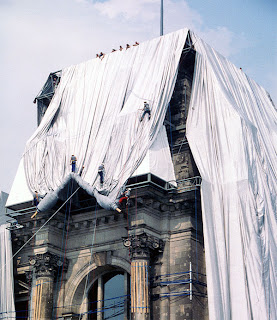As I have been studying architecture, I have been researching many different architects. While this has been interesting, I thought it could also be exciting to take a new approach to the title, and look at Christo’s work. Although not an architect per say, Christo’s work wrapping buildings definitely links to the ideas of art and architecture, while taking a new, original approach. With work including the wrapping of the Pont-Neuf Bridge in Paris, the 24-mile-long Running Fence in California, The Gates in New York City’s Central Park, and Surrounded Islands in Miami, Christo is highly accomplished. His piece most relating to architecture though is the Wrapped Reichstag in Berlin, and I find this project one of his best.
 |
| The Gates |
 |
| Surrounded Islands |
 |
| Pont Neuf Bridge |
 |
| Running Fence |
The Reichstag building is one of Berlin’s most historical landmarks. Opened in 1894, it housed the German Reichstag until 1933, when a fire severely damaged the building. During Germany’s separation, East Germany’s parliament met in the Palace of the Republic, while West Germany’s parliament met in the Bundeshaus in Bonn, and so the Reichstag continued to be neglected. It was not until the reunification of Germany in October 1990, that the Reichstag building underwent construction, and once again became the seat of the German parliament.
Christo and his wife, Jeanne-Claude, pressed to wrap the building from 1971, after receiving a postcard proposing the idea from Berlin historian, Michael Cullen. It was only in 1994 that a close vote in parliament finally gave them permission to wrap the building. The wrapping began June 17th, 1995, and was completed by June 24th. The piece remained wrapped on display until July 7th.
Although only on display for a brief two weeks, this art transformed one of Germany’s most important national symbols. By wrapping the Reichstag, the intricate details of the structures were hidden, and the overall shape was left behind. The silver material highlights the features and proportions of the imposing structure, revealing the essence of the Reichstag building. Once wrapped, the building takes on a new identity, as the imposing and solid structure becomes airy and nomadic. One of my favourite, and certainly one of his best-known pieces, the Wrapped Reichstag by Christo is an incredible piece of art, cultural event and political happening, all in one.































